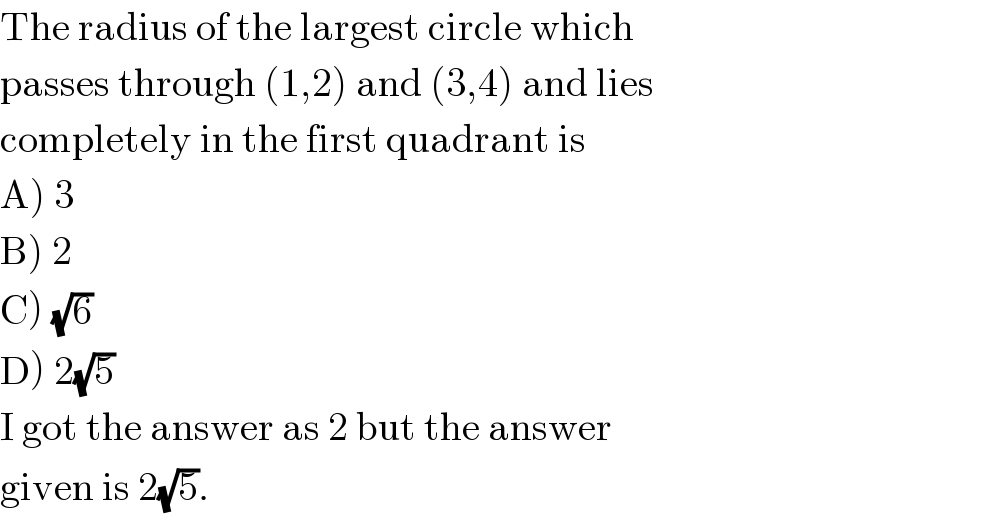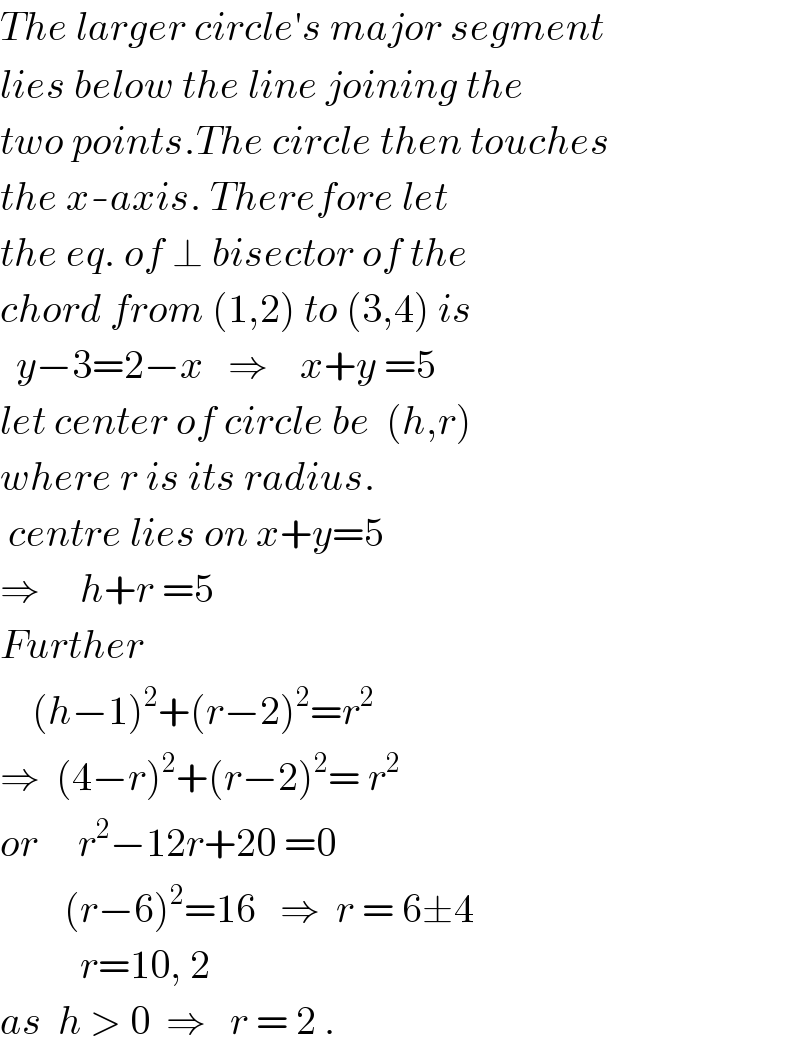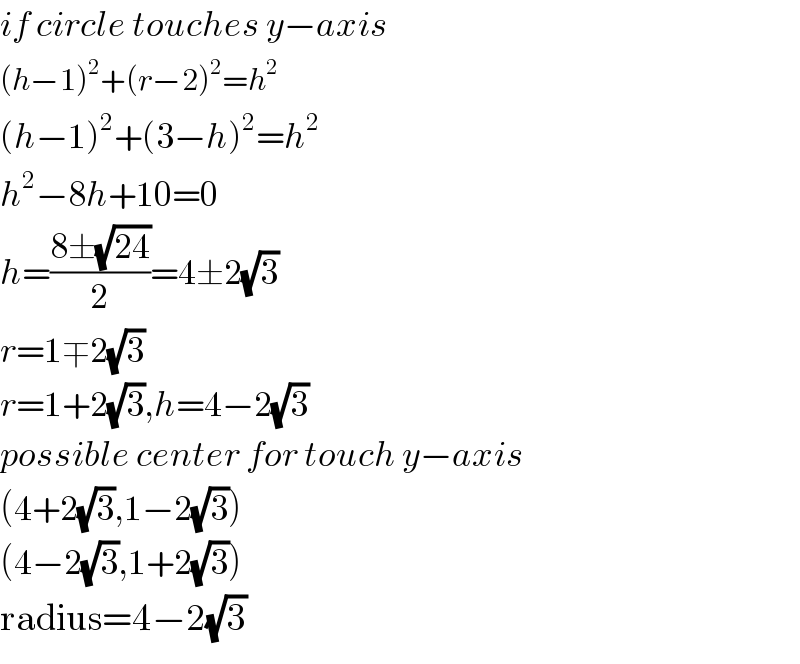Question Number 38613 by rish@bh last updated on 27/Jun/18

$$\mathrm{The}\:\mathrm{radius}\:\mathrm{of}\:\mathrm{the}\:\mathrm{largest}\:\mathrm{circle}\:\mathrm{which} \\ $$$$\mathrm{passes}\:\mathrm{through}\:\left(\mathrm{1},\mathrm{2}\right)\:\mathrm{and}\:\left(\mathrm{3},\mathrm{4}\right)\:\mathrm{and}\:\mathrm{lies} \\ $$$$\mathrm{completely}\:\mathrm{in}\:\mathrm{the}\:\mathrm{first}\:\mathrm{quadrant}\:\mathrm{is} \\ $$$$\left.\mathrm{A}\right)\:\mathrm{3} \\ $$$$\left.\mathrm{B}\right)\:\mathrm{2} \\ $$$$\left.\mathrm{C}\right)\:\sqrt{\mathrm{6}} \\ $$$$\left.\mathrm{D}\right)\:\mathrm{2}\sqrt{\mathrm{5}} \\ $$$$\mathrm{I}\:\mathrm{got}\:\mathrm{the}\:\mathrm{answer}\:\mathrm{as}\:\mathrm{2}\:\mathrm{but}\:\mathrm{the}\:\mathrm{answer}\: \\ $$$$\mathrm{given}\:\mathrm{is}\:\mathrm{2}\sqrt{\mathrm{5}}. \\ $$
Answered by ajfour last updated on 27/Jun/18

$${The}\:{larger}\:{circle}'{s}\:{major}\:{segment} \\ $$$${lies}\:{below}\:{the}\:{line}\:{joining}\:{the} \\ $$$${two}\:{points}.{The}\:{circle}\:{then}\:{touches} \\ $$$${the}\:{x}-{axis}.\:{Therefore}\:{let} \\ $$$${the}\:{eq}.\:{of}\:\bot\:{bisector}\:{of}\:{the} \\ $$$${chord}\:{from}\:\left(\mathrm{1},\mathrm{2}\right)\:{to}\:\left(\mathrm{3},\mathrm{4}\right)\:{is} \\ $$$$\:\:{y}−\mathrm{3}=\mathrm{2}−{x}\:\:\:\Rightarrow\:\:\:\:{x}+{y}\:=\mathrm{5} \\ $$$${let}\:{center}\:{of}\:{circle}\:{be}\:\:\left({h},{r}\right) \\ $$$${where}\:{r}\:{is}\:{its}\:{radius}. \\ $$$$\:{centre}\:{lies}\:{on}\:{x}+{y}=\mathrm{5}\: \\ $$$$\Rightarrow\:\:\:\:\:{h}+{r}\:=\mathrm{5} \\ $$$${Further} \\ $$$$\:\:\:\:\left({h}−\mathrm{1}\right)^{\mathrm{2}} +\left({r}−\mathrm{2}\right)^{\mathrm{2}} ={r}^{\mathrm{2}} \\ $$$$\Rightarrow\:\:\left(\mathrm{4}−{r}\right)^{\mathrm{2}} +\left({r}−\mathrm{2}\right)^{\mathrm{2}} =\:{r}^{\mathrm{2}} \\ $$$${or}\:\:\:\:\:{r}^{\mathrm{2}} −\mathrm{12}{r}+\mathrm{20}\:=\mathrm{0} \\ $$$$\:\:\:\:\:\:\:\:\left({r}−\mathrm{6}\right)^{\mathrm{2}} =\mathrm{16}\:\:\:\Rightarrow\:\:{r}\:=\:\mathrm{6}\pm\mathrm{4} \\ $$$$\:\:\:\:\:\:\:\:\:\:{r}=\mathrm{10},\:\mathrm{2} \\ $$$${as}\:\:{h}\:>\:\mathrm{0}\:\:\Rightarrow\:\:\:{r}\:=\:\mathrm{2}\:. \\ $$
Commented by rish@bh last updated on 27/Jun/18

$$\mathrm{Thank}\:\mathrm{you} \\ $$
Commented by prakash jain last updated on 28/Jun/18

$${if}\:{circle}\:{touches}\:{y}−{axis} \\ $$$$\left({h}−\mathrm{1}\right)^{\mathrm{2}} +\left({r}−\mathrm{2}\right)^{\mathrm{2}} ={h}^{\mathrm{2}} \\ $$$$\left({h}−\mathrm{1}\right)^{\mathrm{2}} +\left(\mathrm{3}−{h}\right)^{\mathrm{2}} ={h}^{\mathrm{2}} \\ $$$${h}^{\mathrm{2}} −\mathrm{8}{h}+\mathrm{10}=\mathrm{0} \\ $$$${h}=\frac{\mathrm{8}\pm\sqrt{\mathrm{24}}}{\mathrm{2}}=\mathrm{4}\pm\mathrm{2}\sqrt{\mathrm{3}} \\ $$$${r}=\mathrm{1}\mp\mathrm{2}\sqrt{\mathrm{3}} \\ $$$${r}=\mathrm{1}+\mathrm{2}\sqrt{\mathrm{3}},{h}=\mathrm{4}−\mathrm{2}\sqrt{\mathrm{3}} \\ $$$${possible}\:{center}\:{for}\:{touch}\:{y}−{axis} \\ $$$$\left(\mathrm{4}+\mathrm{2}\sqrt{\mathrm{3}},\mathrm{1}−\mathrm{2}\sqrt{\mathrm{3}}\right) \\ $$$$\left(\mathrm{4}−\mathrm{2}\sqrt{\mathrm{3}},\mathrm{1}+\mathrm{2}\sqrt{\mathrm{3}}\right) \\ $$$$\mathrm{radius}=\mathrm{4}−\mathrm{2}\sqrt{\mathrm{3}} \\ $$
